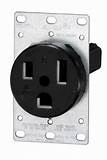kwired
Electron manager
- Location
- NE Nebraska
I think he is reading into this too hard.He says that if there was an intention to allow cord and plug 250.140 would have used the words outlet, receptacle outlets, and junction boxes.
this is the article violation I received:
250.138 Cord-and-Plug-Connected Equipment.
Non–current-carrying metal parts of cord-and-plug-connected equipment, if required to be connected to an equipment grounding conductor, shall be connected by one of the methods in 250.138(A) or (B).
(A) By Means of an Equipment Grounding Conductor.
By means of an equipment grounding conductor run with the power supply conductors in a cable assembly or flexible cord properly terminated in a grounding-type attachment plug with one fixed grounding contact.
Exception:
The grounding contacting pole of grounding-type plug-in ground-fault circuit interrupters shall be permitted to be of the movable, self-restoring type on circuits operating at not over 150 volts between any two conductors or over 150 volts between any conductor and ground.
(B) By Means of a Separate Flexible Wire or Strap.
By means of a separate flexible wire or strap, insulated or bare, connected to an equipment grounding conductor, and protected as well as practicable against physical damage, where part of equipment.
250.140 references 250.138 for the purposes of cord and plug which would require a receptacle outlet. There are no EGC exceptions for receptacle outlets.
You are allowed an outlet according to 250.140, and 250.134 states that you may have it fixed or hard-wired which will use an outlet but not a receptacle. Once you put a receptacle on the outlet for cord and plug you must reference 250.138 for the receptacle. There’s no EGC exception in that article. 250.140 only states outlet and junction boxes. If it was the intention of the code to allow a receptacle, 250.140 would have specifically used the words outlet, receptacle outlets and junction boxes.
please refer to your NEC 2020 Code and find me a specific article that conflicts this.
I still feel the code permits (with conditions) using the grounded conductor of the supply circuit to bond frames of ranges and dryers. That code basically ends at the receptacle when one is present. The appliance is listed to be connected with said 3 wire cord and plug. If no receptacle then code ends at the termination compartment of the appliance.


